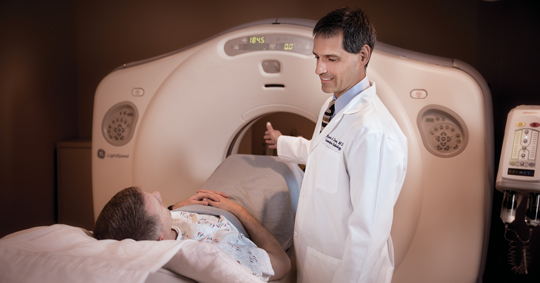CT Scan vs. MRI: What to Expect During Your Screening
Imaging can be intimidating. It’s perfectly normal for patients to have questions and feelings of uncertainty. Which imaging test is right for me? What should I expect? What if they find something? At DRI Greensboro Imaging, the care of our local Triad residents is our top priority, so we want to help alleviate your concerns as much as we can in advance. Understanding how your procedure works and what to expect can help you feel prepared and more comfortable when you arrive.

Two of the most common procedures we perform are computed tomography (CT) scans and magnetic resonance imaging (MRI). They are similar in nature because they both show cross-sectional images of the body, but each is recommended for different reasons and has its own benefits.
Computed Tomography Scan
A CT scan involves taking a series of cross-sectional images, called slices, and putting them together electronically to create a series of images of multiple planes. The procedure does require radiation but uses a low dose X-ray beam to limit exposure. This quick, painless test can be used to detect tumors, infections and injuries to internal organs or bones. CT scans are also commonly used for lung cancer screenings and virtual colonoscopies. The test itself usually only lasts a few minutes, but in more complex cases can last up to half an hour. CT scanners are very open, so patients don’t need to be concerned about feeling confined in a small space.
What to Expect During a CT Scan:
- Depending on the area of the body being scanned and the reason for the exam, you may be required to drink oral contrast so the bowel can be evaluated. Also, you may require an IV injection of contrast (dye) to help evaluate certain anatomy, like blood vessels, and certain conditions.
- Patients will be asked to lie down on a table that moves through the doughnut-shaped CT scanner. As the table moves, the CT scanner sends a thin X-ray beam through the body. The beam is measured by a computer and converted into a cross-sectional picture of the body.
- Throughout the scan, the patient is accompanied by a technologist who gives simple, clear instructions. Once the test is complete, the images are reviewed by a radiologist. In some instances, patients may be asked to wait until the images are reviewed to ensure additional imaging is not necessary.
CT Scans may not be suitable for patients who are pregnant.
Magnetic Resonance Imaging
An MRI uses radio waves rather than radiation to capture an image of the body and detect the location and size of abnormalities. This procedure is well suited for examining areas of the body like the brain, skeletal system and reproductive system. The test typically takes a little longer than a CT scan and consists of several short scans that last from two to eight minutes each. The full procedure can last anywhere from 30 to 60 minutes. DRI Greensboro Imaging offers both closed and open MRIs. Open MRIs provide a more comfortable option for patients who may be claustrophobic, elderly or overweight.
In addition to traditional MRI, we also offer 3T MRI—the most advanced MRI testing available. The strong 3T magnet is ideal for patients who are experiencing neurological or other issues that require detailed images because it provides sharper images. Organs that don’t require extreme detail can be imaged in about half the time of a traditional MRI.
What to Expect During an MRI:
- Usually, no special preparation is necessary prior to an MRI exam. For most exams, you can eat and drink as usual and take any prescription medicine you need. Before beginning, you’ll be asked to remove makeup, eyeglasses, watches, jewelry, credit cards, dentures, hearing aids and any other metallic objects. The technologist will go over any special circumstances that may limit the use of the magnetic field.
- Be sure to tell the technologist if you are or could be pregnant.
- Typically, an MRI exam does not require contrast, but in some situations, it may be needed to enhance MRI visibility.
- The patient will be asked to lie on their back and the part of the body being scanned will be placed in the middle of the magnet.
- The machine is open on each end and a fan provides air flow throughout the duration of the test for patient comfort. There is also a two-way intercom system between the patient and the technologist in case any concerns arise during the test.
MRIs may not be appropriate for patients who are severely claustrophobic or have pacemakers, defibrillators or aneurysm clips.
The DRI Greensboro Imaging staff wants our patients to feel as comfortable as possible for every step of the imaging process. To learn more about our services or to schedule an appointment, call us at 336.433.5000.
